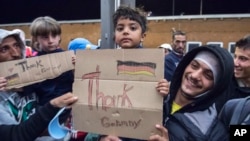Inside the strip mall in Stockholm's Rinkeby neighborhood, a string of Swedish flags hangs over a coffee shop offering Swedish cinnamon buns and Middle Eastern pastry.
In Rinkeby, Swedish culture has long lived side by side with traditions from the Middle East and Africa, but the Swedish influence has waned as more and more immigrants move in and Swedes move out.
“This is not Sweden, it's Mogadishu,” said Saud Mohammed, 75, a Moroccan who lives in the neighborhood where nine out of 10 residents are first or second-generation immigrants, mainly from Somalia, Iraq and Turkey. “Before it used to be mixed. But the Swedes have run away.”
There's no doubting that immigration transforms neighborhoods and towns, and that this year's wave of hundreds of thousands of people fleeing war and poverty in their homelands will have the same effect.
Experts say, however, that there's virtually no chance that the newcomers will radically change the demographics or cultural makeup of the continent - as many populist leaders have contended.
They cite recent research by the U.S.-based Pew Research Center which estimated that in 2010 Muslims made up 6 percent of the population of Europe and Russia and this was expected to rise to just over 10 percent by 2050. In the same period, the percentage of Christians is set to decline from 74.5 percent to just over 65 percent - with part of that decline due to the increasing numbers of those with Christian backgrounds who are turning their backs on religion altogether.
Hungary's hardline Prime Minister Viktor Orban, who built a razor-wire fence along the border with Serbia to stem the flow of migrants, argues that he wants to protect Europe's traditionally Christian culture from becoming “a minority interest in its own continent.”
No minority status for Christians
Demographers say such fears are unfounded although projections of numbers of migrants may need to be updated.
“It is impossible that Christians will become a European minority in the foreseeable future,” said Ruth Mueller, a demographics expert at the Berlin Institute for Population and Development.
“Even though the number of asylum-seekers as well as residence permits has strongly increased, the demographic effects will be rather modest,” she said.
Another key reason why no major demographic shift is expected is that Europe already is home to millions of migrants.
Germany, Europe's economic powerhouse with a population of 81 million, already has a foreign population of roughly 10 percent - a figure that includes citizens of other European countries. Officials expect the number of migrants arriving this year to reach at least 800,000.
To many Swedes, Rinkeby has come to symbolize failed integration policies, even if the problems are not as bad as in the worst neighborhoods of major U.S. cities.
Rinkeby has had problems with crime for decades and, in recent years, with radical Islamic groups recruiting jihadi fighters. There are occasional clashes between police and stone-throwing youths. A man was shot to death on the square a few weeks ago.
Work, not welfare
Nando Sigona, a senior lecturer at the School of Social Policy at the University of Birmingham in England, agreed with the overall picture presented by Mueller, although he said the high number of arrivals will have an impact on welfare systems, “especially at a time of severe cuts and restructurings.”
He stressed, however, that many of those arriving want to get to work, not live on welfare.
“One of the reasons people are moving is that after... years of civil war they are really tired of being parked in a refugee camp without doing much,” said Sigona.
Particularly in large cities, infrastructure like community centers and social services are already in place to absorb the new arrivals and help them adapt to their new lives.
Smaller towns and villages may be more resistant to change.
In Purmerend, a town north of the Dutch capital, Amsterdam, the mayor called the police Thursday night after protesters chanting “no asylum-seeker center” disturbed a meeting at city hall to discuss offering shelter to 750 refugees in a new center or at two former schools.
Integration issues
In Germany, the single largest group of foreigners is from Turkey, at 1.5 million, and Turks or people of Turkish background make up most of the country's estimated 4 million Muslims.
Many arrived in the 1960s as “guest workers” to provide labor in Germany's booming postwar economy. Though thought of as temporary workers, many stayed.
But integration has been slow, with German schools only recently starting to introduce Islamic religion instruction in certain areas. Various states have seen local attempts over the past decade to ban headscarves in public schools, but the country's top court earlier this year ruled that Muslim teachers can wear their headscarves so long as they do not disrupt school activities.
Despite such historical challenges, German Chancellor Angela Merkel believes her country is up to the task of absorbing the new wave of immigrants.
“Because what we're experiencing now, that's something which will continue to occupy our country in the coming years, changing it,” Merkel said recently. "And we want it to change for the better. And we think we can do this.”







